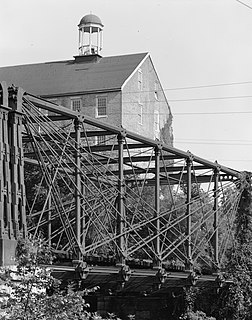
The Bollman Truss Railroad Bridge at Savage, Maryland is the sole surviving example of a revolutionary design in the history of American bridge engineering. The 160-foot (48.8 m) double-span is a suspension truss bridge. The first Bollman bridge was installed on the site; however, the current bridge is not the original. The current bridge was built in 1852 and moved to the site thirty years later. It is one of the oldest standing iron railroad bridges in the United States. Currently, however, it is in use carrying the Savage Mill Trail across the Little Patuxent River.

The Parkersburg Bridge crosses the Ohio River between Parkersburg, West Virginia, and Belpre, Ohio. Designed by Jacob Linville, the bridge has 46 spans: 25 deck plate girder, 14 deck truss, 6 through truss, and 1 through plate girder. 50,000 cubic yards (38,000 m3) of stone were used for the 53 piers. The bridge was constructed from May 1869 to January 1871 by the Baltimore and Ohio Railroad. At the time of its completion, the bridge was reportedly the longest in the world at 7,140 feet (2,180 m).
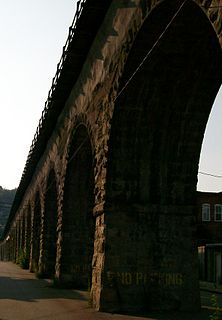
B & O Railroad Viaduct is a historic structure in Bellaire, Ohio, listed in the National Register of Historic Places on June 22, 1976.

The Bardwell's Ferry Bridge, built in 1882, is an historic lenticular truss bridge spanning the Deerfield River between the towns of Shelburne and Conway in Franklin County, Massachusetts. The bridge is listed on the National Register of Historic Places.

The Atherton Bridge is a historic iron truss bridge in Lancaster, Massachusetts, spanning the South Branch of the Nashua River. It is a rare example of a hybrid pony truss that is similar to the 19th century truss design of Simeon S. Post. It was built by J. H. Cofrode & Co. of Philadelphia in 1870. It was the first iron bridge to be constructed in the town. The bridge was added to the National Register of Historic Places in 1979.
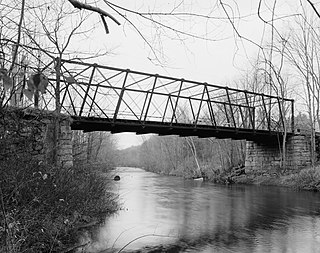
The Ponakin Bridge is a historic Post truss bridge spanning the Nashua River in northern Lancaster, Massachusetts. The bridge was built in 1871, and originally carried the main north–south road, which was bypassed by the construction of Massachusetts Route 70. It is now unsafe and closed even to pedestrians. The bridge, with a design once common but now extremely rare, was listed on the National Register of Historic Places in 1979.

Bartlett's Bridge is a historic stone arch bridge carrying Clara Barton Road over the French River in Oxford, Massachusetts. Built in 1889, it is a rare example of late 19th-century stone bridge construction in the state. It was originally built to provide improved capacity for vehicles servicing a nearby textile mill complex. The bridge was listed on the National Register of Historic Places in 2000.
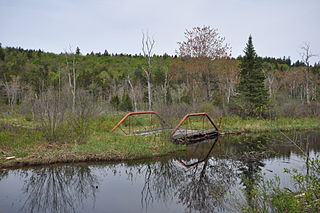
Coleman Bridge is a historic Ball-patent pipe pony truss bridge in Windsor, Massachusetts. It is the only known surviving in situ bridge of its type, one of about two dozen built in western New England. It is located on an abandoned stretch of Windsor Bush Road which crosses Phelps Brook in what is now a remote upland section of Windsor. The bridge was located near farms owned by the Coleman family, giving the bridge its name. The bridge type was invented by Charles H. Ball, an entrepreneur from nearby Peru who developed the idea of using pipes as structural elements of bridges over smaller bodies of water. Only three instances are known to exist, two of which were disassembled and in storage.

The Middlefield–Becket Stone Arch Railroad Bridge District is a historic district extending through parts of the towns of Chester, Middlefield, and Becket, Massachusetts. The district encompasses a 3.7-mile (6.0 km) stretch of railroad right of way in which there are ten bridge crossings, including nine over the west branch of the Westfield River. The bridges were built in four time periods: 1840, 1866, 1912, and 1928. Nine of the ten bridges are stone or concrete masonry work, and one is a truss girder bridge. All are, with only minor exceptions, in excellent and original condition. The bridges were built to carry the Western Railroad through on its run from the Connecticut River to the Hudson River. This section of railroad was the most expensive the company had to build, costing over $1 million in 1840.

Choate Bridge (1764) is a historic stone arch bridge carrying Route 1A/Route 133 over the Ipswich River in Ipswich, Massachusetts. It is one of the oldest surviving bridges in North America, and is probably the oldest in Massachusetts. It was listed on the National Register of Historic Places in 1972.

Bridge L-158 is a disused railroad bridge over Muscoot Reservoir near Goldens Bridge, New York, United States. Built to carry New York Central Railroad traffic over Rondout Creek near Kingston, it was moved to its current location in 1904.

The Bellows Falls Arch Bridge was a three-hinged steel through arch bridge over the Connecticut River between Bellows Falls, Vermont and North Walpole, New Hampshire. It was structurally significant as the longest arch bridge in the United States when it was completed in 1905.

The Blackledge River Railroad Bridge is a Warren truss bridge that was built on the site of a c. 1870 railroad bridge. The original bridge was completed and opened by August 3, 1877. Likely built by the Colchester Railway Company, the bridge was part of the 3.59 miles (5.78 km) of track from Colchester, Connecticut, to Turnerville. The line was leased to the Boston & New York Air Line Railroad and reported improvement in 1879 and a new 110-foot long (34 m) iron bridge by 1881. The line was leased to the New York, New Haven and Hartford Railroad in 1882. After dominating the region, the New York, New Haven and Hartford Railroad petitioned for changes to the Air Line and the approval came on July 7, 1911.

The Fink-Type Truss Bridge was located in the Allerton section of Clinton Township, Hunterdon County, New Jersey, United States. The bridge was built in 1857 by the Trenton Locomotive and Machine Manufacturing Company. It consisted of a single-span through truss 100 feet (30 m) long, 15 feet (4.6 m) wide, and 19 feet (5.8 m) high.
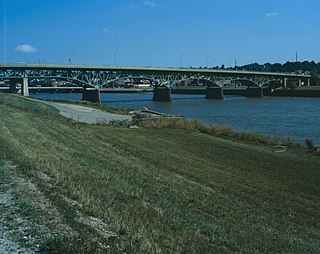
The Jefferson Street Viaduct is an historic structure located in Ottumwa, Iowa, United States. The riveted Warren deck truss bridge was completed in 1936. It was listed on the National Register of Historic Places in 1998 as a part of the Highway Bridges of Iowa MPS.

Bowstring Truss Bridge, also known as the Roaring Run Bowstring Truss Bridge and King Tubular Arch Truss Bridge, is a historic bowstring truss bridge located at the Ironto Rest Area near Ironto, Montgomery County, Virginia. It was built by the King Bridge Company in 1878, and is a single-span, four-panel tubular arch pony truss. It measures 55 feet (17 m) long, 12 feet (3.7 m) wide, and 6 feet 6 inches (1.98 m) high with an open roadway width of approximately 9 feet 6 inches (2.90 m). The bridge was partially disassembled and moved from its original location to a second site during the 1930s, where it remained until moved to its current location in 1977.

Oak Ridge Railroad Overpass is a historic Pratt truss bridge located near Shipman, Nelson County, Virginia. It was built by the Keystone Bridge Company in 1882, and is a single-span, through Pratt truss with two wooden beam approach spans. The span length is 100 feet (30 m). The approach spans are 19 feet (5.8 m) long. It carries VA State Route 653 over the busy Norfolk Southern Washington District, part of the former Southern Main Line between Washington, D.C. and Atlanta.

Nokesville Truss Bridge is a historic Pratt truss bridge spanning the Norfolk Southern Railway near Nokesville, Prince William County, Virginia. It was built in 1882 by the Keystone Bridge Company. The single-span bridge measures 73 feet 11.5 inches (22.543 m) long, and is constructed of wrought iron.

Goshen Land Company Bridge is a historic Pratt through truss bridge spanning the Calfpasture River near Goshen, in Rockbridge County, Virginia, United States. Built in 1890 by the Groton Bridge Company, it consists of two spans, one measuring 138 feet 10 inches (42.32 m) long and the second measuring 120 feet 10 inches (36.83 m); both spans sit at a 30-degree skew.

The East Shoreham Covered Railroad Bridge is a historic covered bridge spanning the Lemon Fair River near East Shoreham, Vermont. Built in 1897 by the Rutland Railroad Company, it is the state's only surviving example of a wooden Howe truss railroad bridge. It was listed on the National Register of Historic Places in 1974.























